 |
 |
|
 |
|
 |
|  |
|  |
|
 |
|
 |
|  |
|  |
|
 |
Did a little testing of the radiosity in beta 30. On simple scenes it is
considerably faster but when I start to adjust the settings it slows
considerably. Here is one example. It can be a little hard to compare
because 3.7 influences the brightness of images so much, but if you adjust
the gamma these images look quite similiar in terms of the quality of the
solution. I might give 3.6 a slight edge in that department. Scenes were
rendered at 640x480, No AA on an Athlon X2 3.21ghz with 2GB RAM.
Unfortunately the test scene is a little over 2mb, otherwise I would upload
it as well.
render times
3.7 - 13m 2s
3.6 - 9m 18s
global_settings {
radiosity {
count 100
nearest_count 10
error_bound 0.02
low_error_factor 0.2
minimum_reuse 0.015
adc_bailout 0.01/2
recursion_limit 3
gray_threshold 0.0
brightness 2
normal on
}
#end
max_trace_level 256
ambient_light 0
}
Post a reply to this message
Attachments:
Download 'VW_3.7radtest_scene.jpg' (175 KB)
Download 'VW_3.6radtest_scene.jpg' (198 KB)
Preview of image 'VW_3.7radtest_scene.jpg'
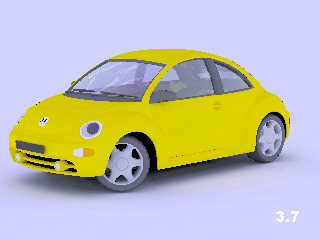
Preview of image 'VW_3.6radtest_scene.jpg'
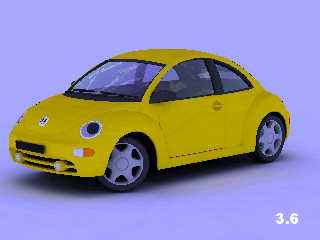
|
 |
|  |
|  |
|
 |
|
 |
|  |
|  |
|
 |
Mike Hough <nos### [at] nospam com> wrote:
> Did a little testing of the radiosity in beta 30. On simple scenes it is
> considerably faster but when I start to adjust the settings it slows
> considerably.
But the radiosity in beta 30 is practically non-working. The beta with
the fixes has not been published yet.
--
- Warp com> wrote:
> Did a little testing of the radiosity in beta 30. On simple scenes it is
> considerably faster but when I start to adjust the settings it slows
> considerably.
But the radiosity in beta 30 is practically non-working. The beta with
the fixes has not been published yet.
--
- Warp
Post a reply to this message
|
 |
|  |
|  |
|
 |
|
 |
|  |
|  |
|
 |
Apparently I misread the post. I will run this again when the binary is
released.
"Warp" <war### [at] tag povray povray org> wrote in message
news:4967676b@news.povray.org...
> Mike Hough <nos### [at] nospam org> wrote in message
news:4967676b@news.povray.org...
> Mike Hough <nos### [at] nospam com> wrote:
>> Did a little testing of the radiosity in beta 30. On simple scenes it is
>> considerably faster but when I start to adjust the settings it slows
>> considerably.
>
> But the radiosity in beta 30 is practically non-working. The beta with
> the fixes has not been published yet.
>
> --
> - Warp com> wrote:
>> Did a little testing of the radiosity in beta 30. On simple scenes it is
>> considerably faster but when I start to adjust the settings it slows
>> considerably.
>
> But the radiosity in beta 30 is practically non-working. The beta with
> the fixes has not been published yet.
>
> --
> - Warp
Post a reply to this message
|
 |
|  |
|  |
|
 |
|
 |
|  |
|  |
|
 |
"Mike Hough" <nos### [at] nospam com> wrote:
> Did a little testing of the radiosity in beta 30.
I suggest not wasting too much time examining performance of radiosity in beta
30, as it is just a beta 29 with a longer "life expectancy" (hm... the term
"beta decay" just comes to my mind ;))
The coming beta will have enough changes in radiosity code to make any
observations in this are perfectly obsolete - both regarding how good your
settings have to be to get rid of artifacts, as well as how long it then takes
to render.
(I can't promise that the "overhauled" radiosity code will be faster than the
beta.29 code in everyday practice - that's what it needs beta testing for - but
I'm sure it will behave significantly different from the beta.29.) com> wrote:
> Did a little testing of the radiosity in beta 30.
I suggest not wasting too much time examining performance of radiosity in beta
30, as it is just a beta 29 with a longer "life expectancy" (hm... the term
"beta decay" just comes to my mind ;))
The coming beta will have enough changes in radiosity code to make any
observations in this are perfectly obsolete - both regarding how good your
settings have to be to get rid of artifacts, as well as how long it then takes
to render.
(I can't promise that the "overhauled" radiosity code will be faster than the
beta.29 code in everyday practice - that's what it needs beta testing for - but
I'm sure it will behave significantly different from the beta.29.)
Post a reply to this message
|
 |
|  |
|  |
|
 |
|
 |
|  |
|  |
|
 |
I ran these scenes with one of the new binaries provided by Chris Cason.
These all were rendered with pvengine32-sse2.exe.
The first image uses the same global settings previously posted. Render time
was 7h 53m before I stopped the render. The low error bound of 0.02 slowed
it to about 7pps.
The second images uses new settings including a higher error_bound and
additional pretrace options to reduce patchiness. These are the only
settings that were changed:
pretrace_start 0.08
pretrace_end 0.02
error_bound 0.15
render time 54 minutes
For the last image I used these new settings to rerun the scene file using
version 3.6. Render time was 3m 58s.
If anyone has any suggestions for how I might alter the settings to improve
the render I would be happy to rerun this test.
Mike
Post a reply to this message
Attachments:
Download 'VW_radbetatest_scene.jpg' (169 KB)
Download 'radbeta_radtest.jpg' (163 KB)
Download '3.6_radtest.jpg' (182 KB)
Preview of image 'VW_radbetatest_scene.jpg'
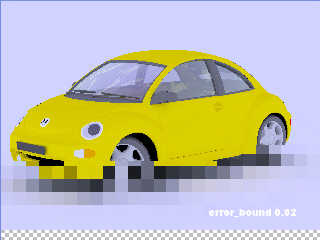
Preview of image 'radbeta_radtest.jpg'
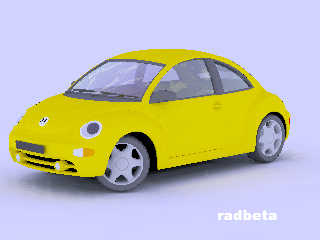
Preview of image '3.6_radtest.jpg'
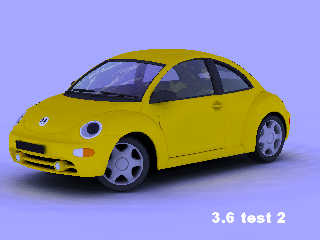
|
 |
|  |
|  |
|
 |
|
 |
|  |
|  |
|
 |
"Mike Hough" <nos### [at] nospam com> wrote:
> If anyone has any suggestions for how I might alter the settings to improve
> the render I would be happy to rerun this test.
- Reduce the nearest_count to 1. There is no point in using any other value
anyway that could not be achieved by modifying the low_error_factor just as
well. Although little known, this was true for 3.6 likewise.
- Increase low_error_factor; having this set to a low value may have helped in
3.6 to reduce artifact "strength", but should no longer be required in
3.7.0.beta.30-rad1. A value of 0.5 should be perfectly fine now in most cases.
Note that with a nearest_count of 10 and a low_error_factor of 0.2, your
pretrace will attempt to achieve a 250-fold (!) higher sample density than
needed for the final trace. (It will never ever achieve this coverage though,
because it will not do enough passes.) Setting nearest_count to 1 and
low_error_factor to 0.5 will cause the pretrace to still aim for 4-fold sample
density.
- Try reducing the recursion_limit, unless you really need three bounces (which
is very rarely the case). The bugs and flaws in 3.6 basically caused deeper
radiosity "bounces" to be limited to a single trace level, i.e. every mirror
and window would look pitch-black to them. The beta.30-rad1 is not so drastic,
with the effect that deep-recursion pretraces take longer than before even with
the same number of samples gathered. com> wrote:
> If anyone has any suggestions for how I might alter the settings to improve
> the render I would be happy to rerun this test.
- Reduce the nearest_count to 1. There is no point in using any other value
anyway that could not be achieved by modifying the low_error_factor just as
well. Although little known, this was true for 3.6 likewise.
- Increase low_error_factor; having this set to a low value may have helped in
3.6 to reduce artifact "strength", but should no longer be required in
3.7.0.beta.30-rad1. A value of 0.5 should be perfectly fine now in most cases.
Note that with a nearest_count of 10 and a low_error_factor of 0.2, your
pretrace will attempt to achieve a 250-fold (!) higher sample density than
needed for the final trace. (It will never ever achieve this coverage though,
because it will not do enough passes.) Setting nearest_count to 1 and
low_error_factor to 0.5 will cause the pretrace to still aim for 4-fold sample
density.
- Try reducing the recursion_limit, unless you really need three bounces (which
is very rarely the case). The bugs and flaws in 3.6 basically caused deeper
radiosity "bounces" to be limited to a single trace level, i.e. every mirror
and window would look pitch-black to them. The beta.30-rad1 is not so drastic,
with the effect that deep-recursion pretraces take longer than before even with
the same number of samples gathered.
Post a reply to this message
|
 |
|  |
|  |
|
 |
|
 |
|  |
|  |
|
 |
I tried lowering nearest_count to 1 and recursion_limit to 2, and increasing
low_error_factor to 0.5. This results in a very blotchy image. I can reduce
that some by lowering the final pretrace to 0.005 and increasing the count
but it takes very long to render and is still a bit patchy.
Stumped, I tried the cornell.pov scene. It renders in 30 seconds in the beta
and 1m 31s in v3.6, so for that scene at least there is a major decrease in
render time and the result looks pretty much identical. So I copied and
pasted the radiosity settings from cornell.pov into my scene and reran the
scene file. In the beta is takes 2m 59s and in v3.6 it takes 3m 9s. There
are some very slight differences but for the most part the images look
almost identical, even the brightness of the image. However there is no
detail evident, just some patchy shadows and color bleeding.
I might see if I can find some off Gilles Tran's old radiosity test files.
"clipka" <nomail@nomail> wrote in message
news:web.496fcbd296903692dea10790@news.povray.org...
> "Mike Hough" <nos### [at] nospam com> wrote:
>> If anyone has any suggestions for how I might alter the settings to
>> improve
>> the render I would be happy to rerun this test.
>
> - Reduce the nearest_count to 1. There is no point in using any other
> value
> anyway that could not be achieved by modifying the low_error_factor just
> as
> well. Although little known, this was true for 3.6 likewise.
>
> - Increase low_error_factor; having this set to a low value may have
> helped in
> 3.6 to reduce artifact "strength", but should no longer be required in
> 3.7.0.beta.30-rad1. A value of 0.5 should be perfectly fine now in most
> cases.
>
> Note that with a nearest_count of 10 and a low_error_factor of 0.2, your
> pretrace will attempt to achieve a 250-fold (!) higher sample density than
> needed for the final trace. (It will never ever achieve this coverage
> though,
> because it will not do enough passes.) Setting nearest_count to 1 and
> low_error_factor to 0.5 will cause the pretrace to still aim for 4-fold
> sample
> density.
>
> - Try reducing the recursion_limit, unless you really need three bounces
> (which
> is very rarely the case). The bugs and flaws in 3.6 basically caused
> deeper
> radiosity "bounces" to be limited to a single trace level, i.e. every
> mirror
> and window would look pitch-black to them. The beta.30-rad1 is not so
> drastic,
> with the effect that deep-recursion pretraces take longer than before even
> with
> the same number of samples gathered.
>
> com> wrote:
>> If anyone has any suggestions for how I might alter the settings to
>> improve
>> the render I would be happy to rerun this test.
>
> - Reduce the nearest_count to 1. There is no point in using any other
> value
> anyway that could not be achieved by modifying the low_error_factor just
> as
> well. Although little known, this was true for 3.6 likewise.
>
> - Increase low_error_factor; having this set to a low value may have
> helped in
> 3.6 to reduce artifact "strength", but should no longer be required in
> 3.7.0.beta.30-rad1. A value of 0.5 should be perfectly fine now in most
> cases.
>
> Note that with a nearest_count of 10 and a low_error_factor of 0.2, your
> pretrace will attempt to achieve a 250-fold (!) higher sample density than
> needed for the final trace. (It will never ever achieve this coverage
> though,
> because it will not do enough passes.) Setting nearest_count to 1 and
> low_error_factor to 0.5 will cause the pretrace to still aim for 4-fold
> sample
> density.
>
> - Try reducing the recursion_limit, unless you really need three bounces
> (which
> is very rarely the case). The bugs and flaws in 3.6 basically caused
> deeper
> radiosity "bounces" to be limited to a single trace level, i.e. every
> mirror
> and window would look pitch-black to them. The beta.30-rad1 is not so
> drastic,
> with the effect that deep-recursion pretraces take longer than before even
> with
> the same number of samples gathered.
>
>
Post a reply to this message
|
 |
|  |
|  |
|
 |
|
 |
|  |




![]()